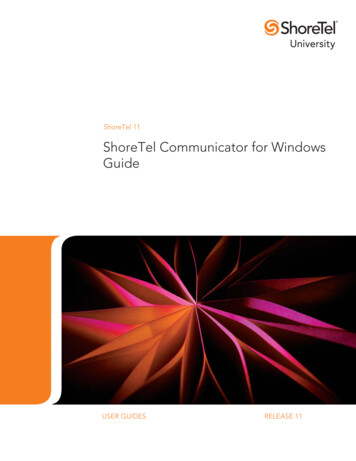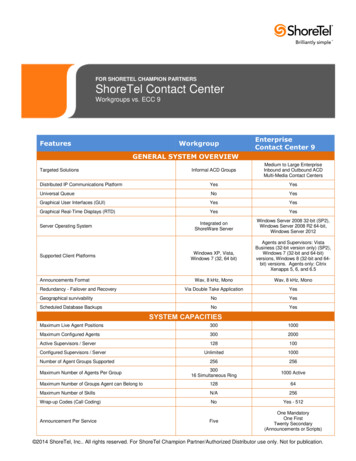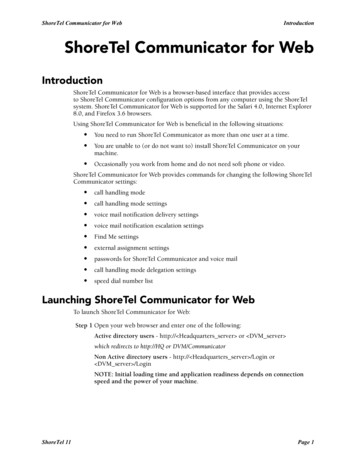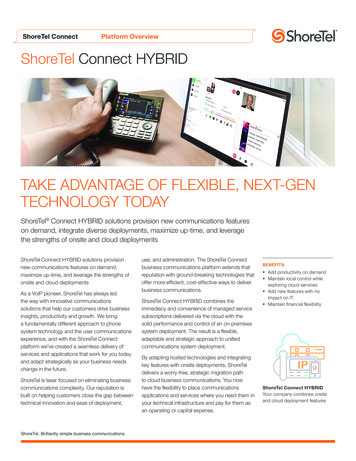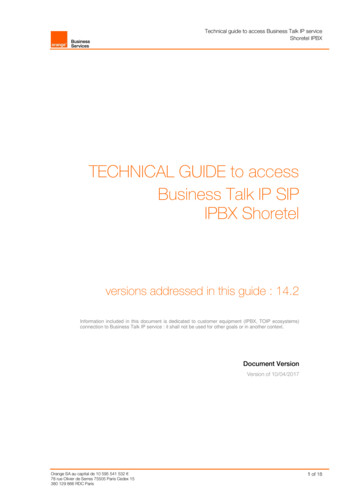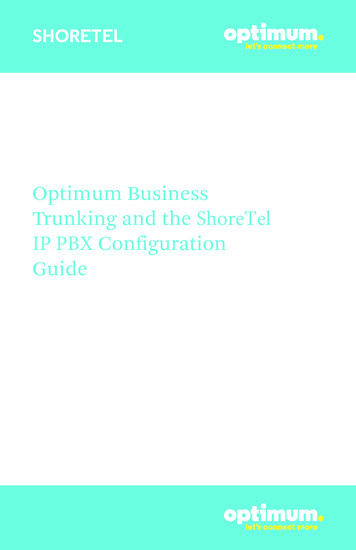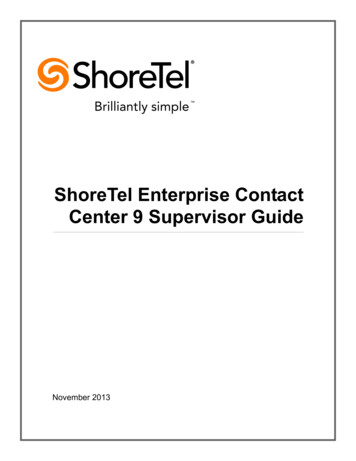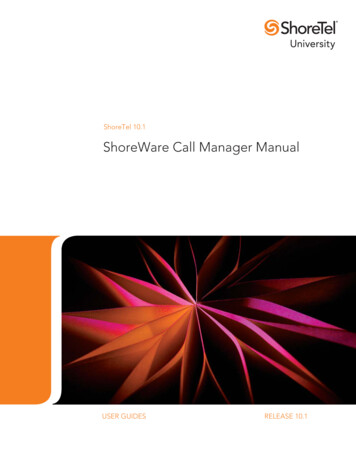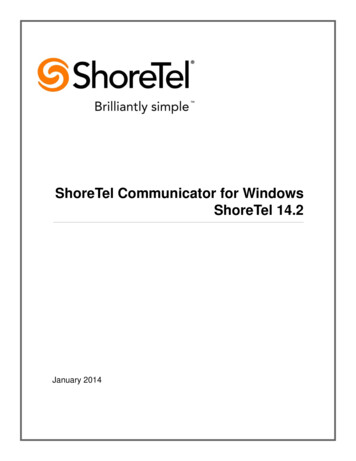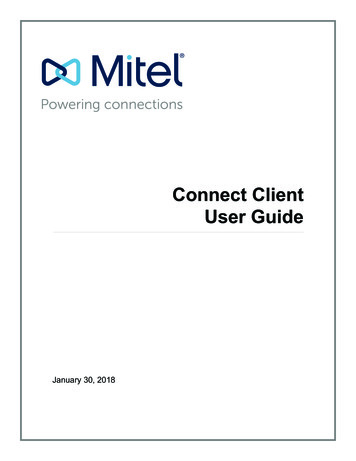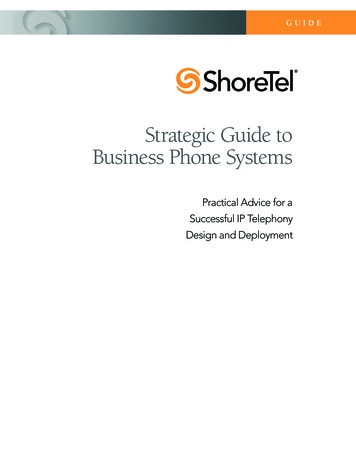
Transcription
GUIDEStrategic Guide toBusiness Phone SystemsPractical Advice for aSuccessful IP TelephonyDesign and Deployment
STRATEGIC GUIDE TO BUSINESS PHONE SYSTEMSTable of ContentsPage NoBusiness Communications: Boost Productivity and Collaboration. 3Get Ready for IP Telephony. 4 Three Steps to Justify Your Organization’s Financial Investmentin Unified Communications. 4 Thorough RFPs Go a Long Way Toward SuccessfulUnified Communications Deployments. 6 Why Leasing Your UC System Might Just Make Perfect Sense. 8 The Seven Most Common Mistakes of IP Telephony Deployment— and How to Short-Circuit Them. 10Build the Network Infrastructure. 12 Keep Your Network Primed for IP Telephony. 12 Disaster Recovery for Your UC System:Design Reliability into Your Architecture. 14 The Globe Turns toward Unified Communications. 17 ShoreTel Gives IP the Green Light with Up to 62 PercentEnergy Savings over Cisco Solution. 20 The Secret Sauce to SIP Trunking. 23Explore IP Telephony Applications. 25 See the Future Now: Affordable, Reliable DesktopVideo Conferencing. 25 Does Your Current Communications System Support Today’s MobileEnterprise? Five Key Requirements for Success. 28 Four Considerations for Selecting IP Phones. 31strate gic guide t o BUSINESS PHONE SYSTEMS pa ge 2
STRATEGIC GUIDE TO BUSINESS PHONE SYSTEMSBusiness Communications:Boost Productivity and CollaborationIP-based telephony systems are transforming the way organizations operate with featuresand functionality that go beyond voice calls and into the heart of improving businessprocesses. An IP platform designed specifically for converged voice and data is essentialfor effectively delivering today’s advanced unified communications (UC) applications. Thegood news for organizations of all sizes is that a converged infrastructure that delivers onthe promise of IP telephony and UC, while leveraging existing investments, exploitingeconomies of scale and streamlining management is now in easy reach.The ShoreTel UC system was designed from the ground up to enable organizations toembrace a true enterprise-class UC strategy that is affordable and easy to manage—especially across multiple sites. ShoreTel’s distributed architecture delivers unmatchedreliability, scalability and manageability, plus a user interface that sets the standard forease-of-use. With proven cost savings and a low total cost of ownership, organizations ofall sizes are discovering that they simply can’t afford not to switch to ShoreTel.To help you understand the key issues involved in choosing and deploying the best UCsolution for your organization, we’ve assembled this strategic guide. Here, you’ll findarticles to help you ensure a successful transition to IP telephony, including the latest tipsand best practices, common mistakes of deployment, steps to justify an investment inUC, and key considerations for selecting IP phones.This strategic guide gives you the tools necessary to facilitate a smooth migration to IPtelephony on a platform for successful UC. If you would like to receive ShoreTel’s monthlynewsletter for industry updates, trend analysis, and information on how you can leverageShoreTel’s UC solutions for competitive advantage, please sign up at www.shoretel.comor e-mail info@shoretel.com.Thank you,The ShoreTel Teamstrate gic guide t o BUSINESS PHONE SYSTEMS pa ge 3
STRATEGIC GUIDE TO BUSINESS PHONE SYSTEMSThree Steps to Justify Your Organization’sFinancial Investment in Unified CommunicationsWith the right approach and concrete research to back up your case, you can convincemanagement to underwrite a UC solution that will significantly improve the way yourorganization does business.Selling a unified communications (UC) strategy to your corporate executives may takesome effort, but with a business-savvy approach and solid research to back up your case,you can convince management to underwrite a solution that will improve the way yourorganization does business at every level. Irwin Lazar, principal research analyst atNemertes Research, offers a few suggestions for selling management on UC’s ability tocreate visibility into the availability of colleagues and partners whose collaboration viae-mail, instant messaging (IM), Web conferencing and other applications is critical incompleting transactions. . Demonstrate a grasp of your organization’s own processes. “The key is to1understand the nature of the business and look for processes in the business that couldbenefit from UC,” Lazar said. s an example, show corporate management a list of steps required to take orders,Apointing out any delays along the way. “Once the order leaves customer service, itoften gets bogged down by a day or more waiting for credit approval,” you mightexplain. “If we had the ability to identify someone in accounts receivable who is able toapprove the order right away, we could shrink the time from order-taking to shipmentby a day or more, which would result in quicker inventory turn, better rates from ourshippers and greater customer satisfaction.” Use examples specific to your own industryand your own company to make UC’s benefits more concrete to those corporatemanagers who approve IT investments. roadly speaking, “IT must become more aware of business process than itBhistorically has been,” said Lazar. IT should speak in terms of actual businessprocesses rather than IT jargon whenever possible. “If at the end of the day, IT can’tshow how the business will save or make money with a particular project, then theproject won’t succeed.” . Take small steps towards a larger business case. “You will be better able to deal2with the integration and management challenges of unified communications if youcan demonstrate a quantifiable productivity increase,” Lazar said. Consider Webconferencing and instant-messaging, which are two components of an overall UCstrategy that may be in regular use at your organization. Discuss these capabilities andthe productivity benefits they have afforded users in your organization to make a casefor investing in a broader UC strategy.strate gic guide t o BUSINESS PHONE SYSTEMS pa ge 4
STRATEGIC GUIDE TO BUSINESS PHONE SYSTEMS he same incremental approach applies to your description of specific businessTprocesses. By understanding each of the steps involved in a single customerinteraction—from the length of time required to complete an action, to the roles of allpersonnel involved in each action, to the script used to up-sell a customer during aspecific interaction—you can build a solid case for a communications strategy that willshave time off each step.“The key is tounderstand thenature of thebusiness andlook forprocesses thatcould benefitfrom UC.”- Irwin Lazar, principalresearch analyst,Nemertes Research . Design and run a UC pilot. In larger organizations, IT or a qualified solutions3provider partner can create a pilot UC system that gives a segment of users a taste ofUC benefits.Consider designating a control group who will engage with customers using currentstandard operating procedures. You’ll compare this group’s interactions—the length oftime called for in each step of the transaction, the speed with which steps follow oneanother, the outcome (sale, no sale, postponement, etc.)—with a second group takingpart in the UC pilot. By comparing data points, such as the amount of time it took tolocate someone to answer a question a customer had, or how rapidly a call wastransferred to a member of the help desk or a person in field support, you will haveevidence of places where inconsistent methods of reaching colleagues resulted in losttime, fewer sales and decreased customer satisfaction.The best pilots typically run over a period of several months, and are followed by asurvey that asks users open-ended, qualitative questions, such as: H ow much time do you estimate using the pilot UC system saved you oncommunications tasks? W here did you see gains in your own productivity during this pilot week? In yourteam’s productivity? What capabilities of the UC system did you use most? Use least?Users may answer these survey questions with descriptions of direct benefits, such as, “Iwas able to get answers more quickly from the sales team when prospects called withquestions,” or “I did not have to waste time tracking down someone from the marketinggroup; I knew they were all in a meeting together until noon,” or with indirect benefits,such as, “We were able to pool all of our medical personnel so none felt the burden ofbeing on call,” or, “Doing so decreased our staff turnover.” Carefully document what theusers say, because their responses and opinions regarding how the UC pilot helpedthem work more efficiently is the most valuable tool you have as you seek todemonstrate UC’s tangible benefits to management and to justify future expenditures.strate gic guide t o BUSINESS PHONE SYSTEMS pa ge 5
STRATEGIC GUIDE TO BUSINESS PHONE SYSTEMSThorough RFPs Go a Long Way Toward SuccessfulUnified Communications DeploymentsWhen crafting a request for proposal for a unified communications solutions, thinkcarefully about what business processes need improvement, and which vendors are bestsuited to meet those needs.If the term “RFP” makes you or your team glaze over, perhaps you need to takeanother look.Yes, it’s time-consuming to prepare, but the generation of a Request for Proposal (RFP)for a unified communications (UC) solution is a process that requires you, as theprospective buyer, to think hard about what business processes need improvement,how such improvements might make your organization run more efficiently, and whichvendors are best suited to meet those needs.“Creating an RFP is akin to shopping for a car,” said Keith Ennenga, senior technicalmarketing engineer at ShoreTel. “Ultimately, you want the seller to give you a price thatfalls within your budget and includes as many of your requested features as possible.”When shopping for a new vehicle, you might have satellite radio, heated seats and 30-plusmiles-per-gallon on your wish list. When you’re in the market for a UC solution, you maywant to request features like integration with Microsoft Outlook; support for interactivevoice response applications; or conference-room phones that support multipoint videofeeds. “An organization in the finance industry will have different requirements than aschool,” Ennega said. The key is pinpointing those requirements and asking three or fourvendors to tell you how their products will solve your business problems.Narrow It DownAn RFP, which is in effect a questionnaire you’re asking your top prospective vendors tofill in, is different from a Request for Information (RFI). An RFI is a preliminary step thathelps you develop your understanding of the landscape of vendors that might meet yourorganization’s needs. Recognize that by the time you are to the point of preparing anRFP, it’s best to be pretty serious about choosing one of the vendors who will receive it.The RFP phase should include a pilot, preliminary budgetary considerations and aproposed implementation timeline. The pilot is like a test drive before you buy that newcar. Your RFP should include some broad guidelines about the pilot’s scope and duration.“Typically, you see pilots running anywhere from 30 to 120 days, with 60 days being themost common,” Ennega said. You should decide whether to test out a UC solutionbetween two branch offices, for example, or in a large department in your organization.Not all details of the pilot are required to go into the RFP. Once you’ve chosen a vendorand/or its professional services partner, you can fine-tune the balance of the details.strate gic guide t o BUSINESS PHONE SYSTEMS pa ge 6
STRATEGIC GUIDE TO BUSINESS PHONE SYSTEMSBe aware that some vendors apply some costs of the pilot toward the cost of animplementation if you choose their solution. If you don’t buy their product, you probablywon’t get a refund from the vendor for costs you bore in association with the pilot.By the NumbersAn RFI is apreliminarystep thatdevelops yourunderstandingof the landscapeof vendors thatmight meet yourorganization’sneeds.The RFP is also devoted to getting a sense of the budget commitments for yourproposed UC solution. You’re asking vendors to estimate the costs of hardware andsoftware associated with an implementation that fits your organization. You’re alsoinquiring about licensing fees, training costs, maintenance contracts costs, labor costs,including programming and professional services performed by the vendor or anauthorized partner, plus any costs associated with upgrading to future software revisions,for which some vendors charge separately.“Make sure you know who is doing what part of the work, whether it’s your ITdepartment, the vendor’s technical sales team, authorized distributors or other parties,”Ennega said. Your RFP also needs to address implementation scenarios, with adiscussion by each vendor of how they propose to roll out the type of UC solution youenvision for your company.Allow a few months to complete the RFP, and realize it will entail your IT staff (or yourconsultants) querying staffers in various departments performing different functionsabout the degree to which their operations are supported (or not) by the solutions inplace now, and what kinds of capabilities would make their jobs easier. All of thisinformation goes toward developing those goals and metrics that will help you build aUC solution that will benefit your organization.Seek Out ExpertsLearn more about preparing RFPs for UC solutions by attending workshops at tradeshows, where consultants often compare and contrast RFPs completed by variousmanufacturers. Many ShoreTel partners maintain libraries of RFPs that companies cancustomize to their particular needs.“A good RFP asks vendors how they would solve a particular issue,” Ennenga said.“Maybe you have three office locations, each with its own independent telephonesolution, and you want to offer extension-to-extension dialing, interoffice paging andother transparent features such as instant messaging or call-center agents working fromhome. As long as the customer knows the business issues to be addressed, a goodvendor should be able to propose workable solutions.”strate gic guide t o BUSINESS PHONE SYSTEMS pa ge 7
STRATEGIC GUIDE TO BUSINESS PHONE SYSTEMSWhy Leasing Your UC System Might JustMake Perfect SenseIn tough economic times, leasing equipment can offer many financial benefits toorganizations that want to implement a cutting-edge UC solution while stillconserving capital.When it comes to purchasing hardware and software for a comprehensive unifiedcommunications (UC) system, several options exist to help organizations move forwardon a platform for future growth. Leasing is one option that is proving increasing popularbecause it allows organizations to implement a cutting-edge UC solution while stillconserving capital.“How a customer buys a UC system is nearly as important as what they buy,” said TimGaines, regional director at ShoreTel. “Normally, when people buy phone systems,they look at the phones’ features, service plans and other factors, and then decide atthe very end of the cycle how they are going to pay for the system. It’s better tobring that discussion to the front of the vetting process, and to compare a potentialreturn on cash (ROC) with return on investment (ROI) for each IP telephony purchaseoption under consideration. You might find that a cutting-edge UC solution is withinyour reach.”When the numbers are run, it’s sometimes surprising to find the most cost-effectivemethod of acquiring the solution is not what a customer initially thought, Gaines added.He sees many raised eyebrows when customers realize that the option that consumesthe least amount of cash is often a lease.Tough Times Enhance Leasing’s Appeal“The current economy means that more companies are feeling the pinch,” said MikeFerry, regional vice president with financial services firm TAMCO. “Cash truly is king, andpreserving cash is more important now than ever.”To help customers make the right purchasing decision, ShoreTel has partnered withTAMCO to create ShoreTel Financial Solutions (SFS), which offers a leasing option for theShoreTel UC system. For customers looking for a financing solution that qualifies asoff-balance sheet financing and provides attractive ROI/ROC benefits, SFS offers a leaseprogram called FlexGuard.“FlexGuard is an all-inclusive managed service program,” Ferry said. “In effect, it’s arental program for IP equipment, which is a depreciating asset.” By leasing rather thanpurchasing, the organization conserves cash for other uses and protects its investment ina rapidly evolving area of technology.strate gic guide t o BUSINESS PHONE SYSTEMS pa ge 8
STRATEGIC GUIDE TO BUSINESS PHONE SYSTEMS“The ShoreTel FlexGuard program provides customers with peace of mind that evolvingtechnology and constantly changing business needs will not have a negative impact,”Gaines said. “FlexGuard allows more customers to take advantage of ShoreTel’s leadingtechnology without the usual risks associated with ownership, such as maintenance costs,system obsolescence and shifts in marketplace demands.”Do the Math and Free up the CashThe cost savingsfrom leasing canadd up quickly,leaving cash freefor morestrategic uses.The potential cost savings of leasing over purchasing can add up quickly, leaving cashfree for other, more strategic uses. Factors that go into the lease versus buy assessment,including amount of cash on hand, amount of money owed to creditors and long-rangebusiness plans, need to be examined on a case-by-case basis and in consultation with afinancial advisor or accountant, Gaines advised. Ideally, both an organization’s IT staffand its financial officers should discuss these issues at the beginning of the UC solutionprocurement process.“TAMCO works closely with organizations to help them choose the best plan for theirneeds today, with a strong focus on their plans for tomorrow,” said Ferry. “For example,many customers prefer to make fixed monthly payments with an option to purchase theequipment outright at the lease’s conclusion. This way, they chip away at the cost to ownthe equipment over time, opting to put it in the balance sheet and to take depreciationwhen their particular financial picture supports it.”The FlexGuard System-Replacement provision protects customers from unforeseenchanges in the status of their business. Flexible end-of-term options and co-terminusadditions make it easier to buy other products as required, such as when a companyopens new branches or closes existing offices. “Customers can opt for an all-inclusiveservice clause that locks in tomorrow’s maintenance at today’s discounted prices,” Ferrysaid. “Actual repair and maintenance is carried out by ShoreTel and its certified partners,which offers peace of mind and helps ensure business continuity.”To help organizations keep cash in the bank during an economic downturn, leasing UCsystem gear might make the best financial c
marketing engineer at ShoreTel. “Ultimately, you want the seller to give you a price that falls within your budget and includes as many of your requested features as possible.” When shopping for a new vehicle, you might have satellite radio, heated seats and 30-
